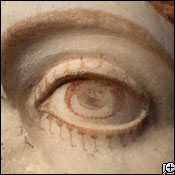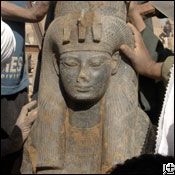It's that time of year again, when chocolates and flowers start doing the rounds and Valentine cards with messages of undying love appear, like mushrooms, overnight.
Have you noticed the mythological allusions in the greeting cards? You can't miss Eros with his tiny arrows, or Cupid as he is more commonly termed to avoid any indelicate reference to biological urges. Tales of legendary lovers abound, Lancelot and Guinevere, Tristan and Isolde, or Hero and Leander. Even Romeo and Juliet get a re-run. But are these loving couples really good role models for a succesful relationship?
Take the young lover theme for example. The original pair were Pyramus and Thisbe, teenagers from opposing families in Ancient Babylon who fell in love, mixed up some messages to each other and ended up dead. Not a very inspiring story to start with, although Shakespeare improved on the material and West Side Story certainly sold a lot of tickets. But overall, it's a most unsatisfactory conclusion.
Then there's the couple kept apart by honour. The story of Tristan and Isolde, like that of Lancelot and Gionevere, is often held up as an example of true and perfect love. All the ingredients for a satisfactory narrative are present; the lightning bolt of desire, the inevitable tragedy, ritual sacrifice, the denial of satisfaction and the purity of renunciation. These days, the path of honourable chastity has lost popularity.
But what else can you expect from the barbed darts of the spiteful Eros? Even Apollo wasn't immune.
While swaggering round one morning the Sun God came across Eros sharpening his darts and, full of his own importance, disparaged the puny weapons. One of these arrows which Eros honed so carefully was to instantly cause infatuation, the other to repel it. The former was of gold and sharp-pointed, the latter blunt and tipped with lead. Full of malice, Eros took up the leaden shaft and struck the nymph Daphne, and with the golden one, he shot the cocky Apollo right through the heart.
Poor Daphne, who wished only to remain unmarried and alone in the deep woods, was immediately pursued by the lustful Apollo. Bent on rape, he chased her relentlessly through the woods. The desperate nympth, finally overcome with exhaustion, turned into a laurel tree. You must admit that while the story may be interesting for mythological reasons, it's not much of a yarn.
Eros even wounded his own mother Venus in the bosom with one of his arrows. Before the wound healed she beheld Adonis, and that was that! Utterly captivated, she left her pleasant garden, and followed the youth through the woods and over the hills and far away. Not the kind of behaviour to be encouraged in mothers at the best of times.
And then there's Zeus. Any love story involving Zeus is essentially a contradiction in itself, the Great Philanderer was at best an overbearing boasting Casanova or at worst, an arch-rapist, that is, until he met Ganymede.
In earlier days, all Greeks were familiar with the tales that told of the many affairs of Zeus, of the ill-fated love of Apollo and Hyacinth, of Achilles and Patroclus, and of many other such passionate friendships between gods or heroes and handsome youths. These stories are not so popular today and many in these modern times have forgotten Ganymede, the most beautiful boy in the world, but in any case, apart from the youth suffering an untimely death, his story isn't universally suitable for a Valentines Day greeting card message.
Perhaps the best Valentine's Day greeting is a simple kiss, a hug, and three little words. It's kept the world going around for a while now.
I've put together a list of
Real Love Legends on the main website at
All Info About Myths & Legends and don't forget, you can get the
Legends and Lore eZine free every fortnight
 This is a peek inside a cavern of roiling dust and gas where thousands of stars are forming.
This is a peek inside a cavern of roiling dust and gas where thousands of stars are forming. 














